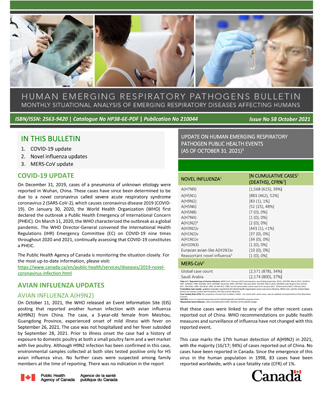Human emerging respiratory pathogens bulletin: Issue 58, October 2021
Download in PDF format
(1.15 MB, 3 pages)
Organization: Public Health Agency of Canada
Date published: 2021-11-10
Monthly situational analysis of emerging respiratory diseases affecting humans (data to October 31, 2021)
In this bulletin
- COVID-2019 update
- Avian influenza updates
- Swine influenza updates
- Middle East respiratory syndrome coronavirus (MERS-CoV) update
| Novel influenzaTable 1 Footnote 1 | Cumulative Case CountTable 1 Footnote 2 | Deaths | Case Fatality Rate %Table 1 Footnote 3 |
|---|---|---|---|
| A(H7N9) | 1,568 | 615 | 39% |
| A(H5N1) | 881 | 462 | 52% |
| A(H9N2) | 83 | 1 | 1% |
| A(H5N6) | 52 | 25 | 48% |
| A(H5N8) | 7 | 0 | 0% |
| A(H7N4) | 1 | 0 | 0% |
| A(H1N2)Table 1 Footnote 4 | 2 | 0 | 0% |
| A(H3N2)v | 441 | 1 | <1% |
| A(H1N2)v | 37 | 0 | 0% |
| A(H1N1)v | 34 | 0 | 0% |
| A(H10N3) | 1 | 0 | 0% |
| Eurasian avian-like A(H1N1) | 10 | 0 | 0% |
| Reassortant novel influenzaTable 1 Footnote 5 | 1 | 0 | 0% |
|
|||
| MERS-CoVTable 2 Footnote 1 | Cumulative Case CountTable 2 Footnote 2 | Deaths | Case Fatality Rate %Table 2 Footnote 3 |
|---|---|---|---|
| Global Case Count | 2,571 | 878 | 34% |
| Saudi Arabia | 2,174 | 800 | 37% |
|
|||
COVID-19 update
On December 31, 2019, cases of a pneumonia of unknown etiology were reported in Wuhan, China. These cases have since been determined to be due to a novel coronavirus called severe acute respiratory syndrome coronavirus 2 (SARS-CoV-2), which causes coronavirus disease 2019 (COVID-19). On January 30, 2020, the World Health Organization (WHO) first declared the outbreak a Public Health Emergency of International Concern (PHEIC). On March 11, 2020, the WHO characterized the outbreak as a global pandemic. The WHO Director-General convened the International Health Regulations (IHR) Emergency Committee (EC) on COVID-19 nine times throughout 2020 and 2021, continually assessing that COVID-19 constitutes a PHEIC.
The Public Health Agency of Canada is monitoring the situation closely.
Avian influenza updates
Avian influenza A(H9N2)
On October 11, 2021, the WHO released an Event Information Site (EIS) posting that reported another human infection with avian influenza A(H9N2) from China. The case, a 3-year-old female from Meizhou, Guangdong Province, experienced onset of mild illness with fever on September 26, 2021. The case was not hospitalized and her fever subsided by September 28, 2021. Prior to illness onset the case had a history of exposure to domestic poultry at both a small poultry farm and a wet market with live poultry. Although H9N2 infection has been confirmed in this case, environmental samples collected at both sites tested positive only for H5 avian influenza virus. No further cases were suspected among family members at the time of reporting. There was no indication in the report that these cases were linked to any of the other recent cases reported out of China. WHO recommendations on public health measures and surveillance of influenza have not changed with this reported event.
This case marks the 17th human detection of A(H9N2) in 2021, with the majority (16/17; 94%) of cases reported out of China. No cases have been reported in Canada. Since the emergence of this virus in the human population in 1998, 83 cases have been reported worldwide, with a case fatality rate (CFR) of 1%.
Avian influenza A(H5N6)
Four (4) human cases of avian influenza A(H5N6) were detected in October 2021 in China. They all reported contact with poultry prior to illness onset. The median age of these cases was 59 years (age range: 52-66 years) and half (2/4; 50%) of the reported cases were male. One of the cases was fatal, one was in serious condition, and the other two were in critical condition at the time of the reports. These 4 cases were detected in two (2) different regions in China: Hunan Province and Guangdong Province. None of the cases were known to be connected to each other, or to previously reported cases.
To date in 2021, 26 cases of avian influenza A(H5N6) have been reported globally (Figure 2); 25 A(H5N6) cases were reported from China and one (1) case was reported from Lao PDR. The 25 cases from China were reported from seven (7) different regions (Figure 3): Guizhou Province, Anhui Province, Guangxi Zhuang Autonomous Region, Sichuan Province, Hunan Province, Guangdong Province, and Chongqing Municipality. The median age of the cases reported in 2021 was 53.5 years (age range: 1-72 years) and 50% (13/26) of these cases were male. At least seven (7) cases reported this year died (Footnote *CFR: 24%); however, most cases were in critical condition at the time of report. None of these cases were known to be connected to each other, or to previously reported cases, other than one couple (husband and wife) who shared a common exposure source (slaughtered and cooked duck). There was no evidence of human-to-human transmission of the virus.
A total of 52 laboratory-confirmed human cases of avian influenza A(H5N6), including at least 25 deaths (Footnote *CFR: 48%) have been reported globally since 2014. No cases have been reported in Canadian residents. The WHO has indicated a need for more human and animal investigations to understand the increased incidence this year as well as to better assess risk.
Swine influenza updates
Swine origin influenza A(H1N2)v
In October 2021, one (1) new human case of A(H1N2)v was detected in Austria. The case, a 29-year-old immunocompromised pig farmer, presented with influenza-like symptoms on August 31. He tested positive for influenza A but negative for SARS-CoV-2 and several other respiratory pathogens. He was hospitalized from September 1 to 3. As of September 12, he was considered fully recovered. The influenza virus isolated from this case is identical to the influenza A/swine/H1N2 virus detected in pigs on the pig farm where the case resides. None of the case's contacts tested positive for influenza A.
Two A(H1N2)v detections have been reported in Canadian residents since reporting began in 2005, with the latest case reported in April 2021. A total of 37 cases have been reported globally since 2005, with a 0% case fatality rate. There have been nine 9 A(H1N2)v cases reported worldwide in 2021.
Swine origin influenza A(H3N2)v
In October 2021, the US CDC reported one (1) new human case of swine origin influenza A(H3N2)v in Ohio from the current season (2021-22). The case, <18 years of age, was not hospitalized. It was unclear whether the case had recovered or was recovering at the time of the report. It was also unclear whether this case had contact with swine prior to illness onset. No ongoing human-to-human transmission was identified in association with this case.
Two A(H3N2)v detections have been reported in Canadian residents since reporting began in 2005, with the latest case reported in June 2021. Globally, 441 A(H3N2)v cases have been reported since 2005, with <1% case fatality rate. There have been 5 A(H3N2)v cases reported worldwide in 2021.
Swine origin influenza A(H1N1)v
In October 2021, the US CDC reported one (1) new human case of swine origin influenza A(H1N1)v in North Dakota that had occurred in the 2020-21 season. The case, <18 years of age, was not hospitalized. It was unclear whether the case had recovered or was recovering at the time of the report. It was also unclear whether this case had contact with swine prior to illness onset. No ongoing human-to-human transmission was identified in association with this case.
Two A(H1N1)v detections have been reported in Canadian residents since reporting began in 2005, with the latest case reported in April 2021. Globally, 34 human cases of A(H1N1)v have been reported since 2005, with no associated fatalities. There have been five (5) A(H1N1)v cases reported worldwide in 2021.
In October 2021, five (5) new human cases of Eurasian avian-like swine influenza A(H1N1)v were reported in China. The five cases were detected through influenza-like illness surveillance between January and March 2021 with onset of illness between December 2020 and March 2021. All five cases are considered sporadic and detected from four provinces: Gansu (2) Hunan (1), Sichuan (1) and Tianjin (1). Four cases were under 15 years of age and one case was 65-years old. All cases presented with mild illness except for a 13-year-old male from Gansu who was admitted to hospital on February 11, 2021, with pneumonia. All cases have since recovered. There is no clear source of exposure for all cases and there were no additional cases reported among family members.
Including these cases, there have been ten (10) human cases since this virus was first reported in 2021 with 90% (9/10) from China. The case fatality rate (CFR) is 0%. No cases have been reported in Canada.
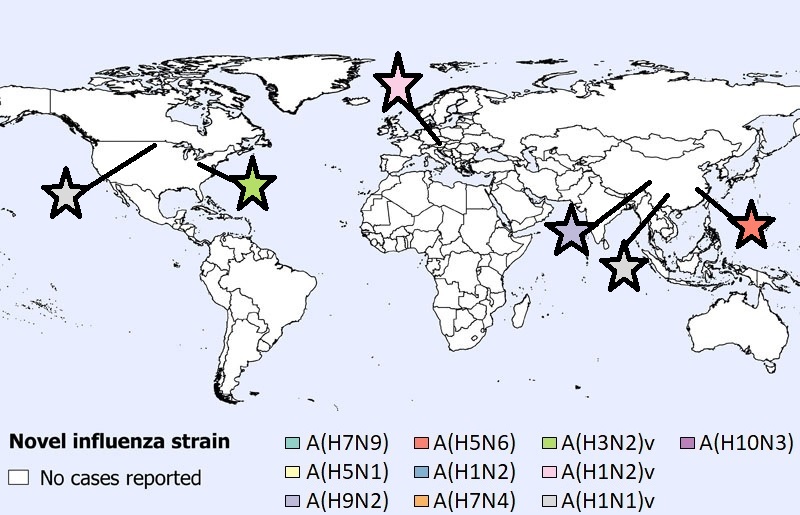
Note: Map was prepared by the Centre for Immunization and Respiratory Infectious Diseases (CIRID) using data from the latest WHO Event Information Site (EIS) postings and Weekly US Influenza Surveillance Reports (FluView). This map reflects data available through these publications as of October 31, 2021.
Figure 1 - Text equivalent
- Five Eurasian avian-like swine influenza A(H1N1)v were reported in China.
- Four A(H5N6) cases were reported in China.
- One A(H9N2) case was reported in China.
- One A(H1N1)v case was reported in the United States of America.
- One A(H1N2)v case was reported in the United States of America.
- One A(H3N2)v case was reported in the United States of America.
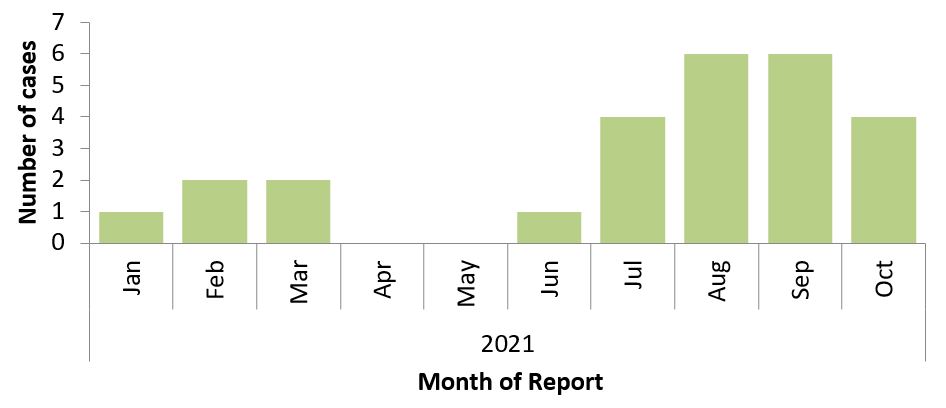
Note: Graph was prepared by the Centre for Immunization and Respiratory Infectious Diseases (CIRID) using data from the WHO EIS postings and the Hong Kong Centre for Health Protection (CHP) press releases. This graph reflects data available as of October 31, 2021.
Figure 2 - Text equivalent
| Month | Cases |
|---|---|
| Jan | 1 |
| Feb | 2 |
| Mar | 2 |
| Apr | 0 |
| May | 0 |
| June | 1 |
| July | 4 |
| Aug | 6 |
| Sep | 6 |
| Oct | 4 |
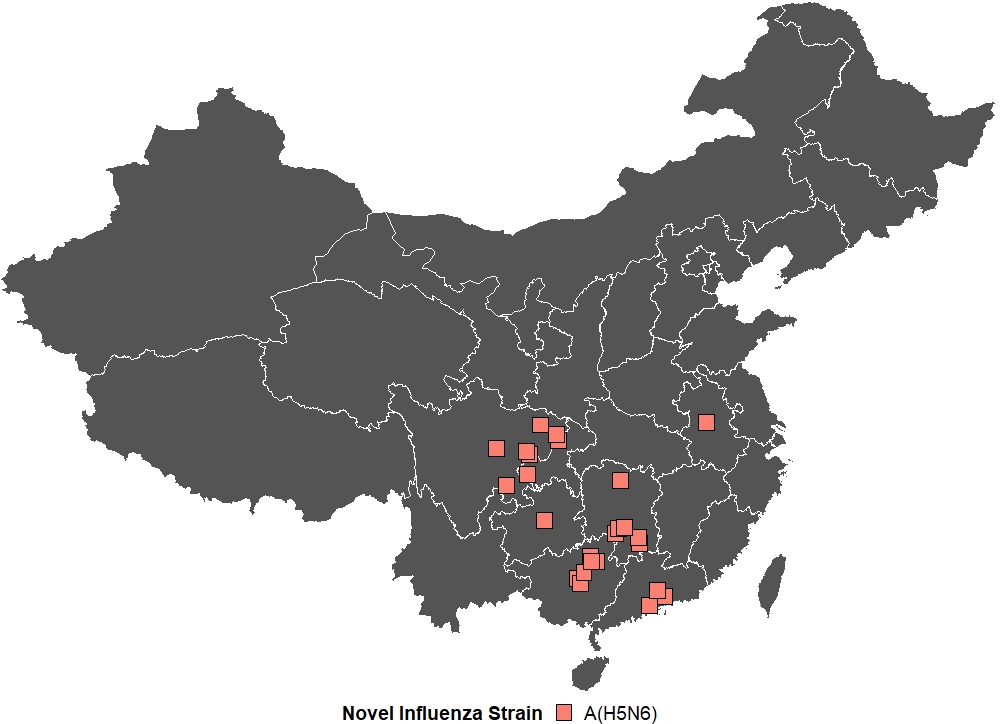
Note: Map was prepared by the Centre for Immunization and Respiratory Infectious Diseases (CIRID) using data from the WHO EIS postings and the Hong Kong Centre for Health Protection (CHP) press releases. This map reflects data available through these publications as of October 31, 2021.
Figure 3 - Text equivalent
- One case was reported out of Yongchuan, Chongqing Municipality.
- One case was reported out of Guizhou Province.
- One case was reported out of Anhui Province.
- Two cases were reported out of Guangxi Zhuang Autonomous Region.
- One case was reported out of Chengdu, Sichuan Province.
- One case was reported out of Bazhong, Sichuan Province.
- One case was reported out of Kaijiang, Sichuan Province.
- Two cases were reported out of Tongnan, Chongqing Municipality.
- One case was reported out of Xuanhan, Sichuan Province.
- Three cases were reported out of Guilin, Guangxi Zhuang Autonomous Region.
- One case was reported out of Yibin, Sichuan Province.
- One case was reported out of Huizhou, Guangdong Province.
- Two cases were repored out of Dongguan, Guangdong Province.
- One case was reported out of Laibin, Guangxi Zhuang Autonomous Region.
- Two cases were reported out of Chenzhou, Hunan Province.
- Three cases were reported out of Yongzhou, Hunan Province.
- One case was reported out of Changde, Hunan Province.
Middle East respiratory syndrome coronavirus (MERS-CoV) update
One new MERS-CoV case was reported from Saudi Arabia in October 2021. The case, a 58-year-old male from Riyadh, reported exposure to camels prior to illness onset and was classified as a primary case (the case likely did not contract the virus from another human).
Including this case, 14 cases of MERS-CoV have been reported globally in 2021 [six (6) of them fatal], with 13 of these cases reported from Saudi Arabia. A total of 2,571 laboratory-confirmed cases of MERS-CoV, including 878 deaths, have been reported globally since 2012 by the WHO. No cases have been reported in Canada.
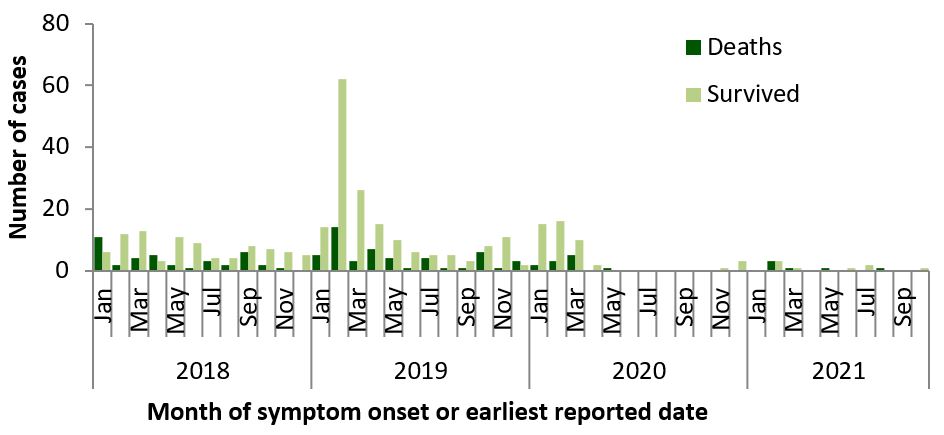
Note: Graph was prepared by the Centre for Immunization and Respiratory Infectious Diseases (CIRID) using data from the WHO Disease Outbreak News and Saudi Arabia's Ministry of Health. This graph reflects data available as of October 31, 2021.
Figure 4 - Text equivalent
| Date | Deaths | Survived | |
|---|---|---|---|
| 2018 | Jan | 11 | 6 |
| Feb | 2 | 12 | |
| Mar | 4 | 13 | |
| Apr | 5 | 3 | |
| May | 2 | 11 | |
| June | 1 | 9 | |
| July | 3 | 4 | |
| Aug | 2 | 4 | |
| Sep | 6 | 8 | |
| Oct | 2 | 7 | |
| Nov | 1 | 6 | |
| Dec | 0 | 5 | |
| 2019 | Jan | 5 | 14 |
| Feb | 14 | 62 | |
| Mar | 3 | 26 | |
| Apr | 7 | 15 | |
| May | 4 | 10 | |
| June | 1 | 6 | |
| July | 4 | 5 | |
| Aug | 1 | 5 | |
| Sep | 1 | 3 | |
| Oct | 6 | 8 | |
| Nov | 1 | 11 | |
| Dec | 3 | 2 | |
| 2020 | Jan | 2 | 15 |
| Feb | 3 | 16 | |
| Mar | 5 | 10 | |
| Apr | 0 | 2 | |
| May | 1 | 0 | |
| June | 0 | 0 | |
| July | 0 | 0 | |
| Aug | 0 | 0 | |
| Sep | 0 | 0 | |
| Oct | 0 | 0 | |
| Nov | 0 | 1 | |
| Dec | 0 | 3 | |
| 2021 | Jan | 0 | 0 |
| Feb | 3 | 3 | |
| Mar | 1 | 1 | |
| Apr | 0 | 0 | |
| May | 1 | 0 | |
| June | 0 | 1 | |
| July | 0 | 2 | |
| Aug | 1 | 0 | |
| Sep | 0 | 0 | |
| Oct | 0 | 1 | |
- Footnote *
-
CFR: case fatality rate. Note that this rate is dependent on accurately reported deaths. For events with active cases, this value may be updated retrospectively as final disposition of the cases is known.
